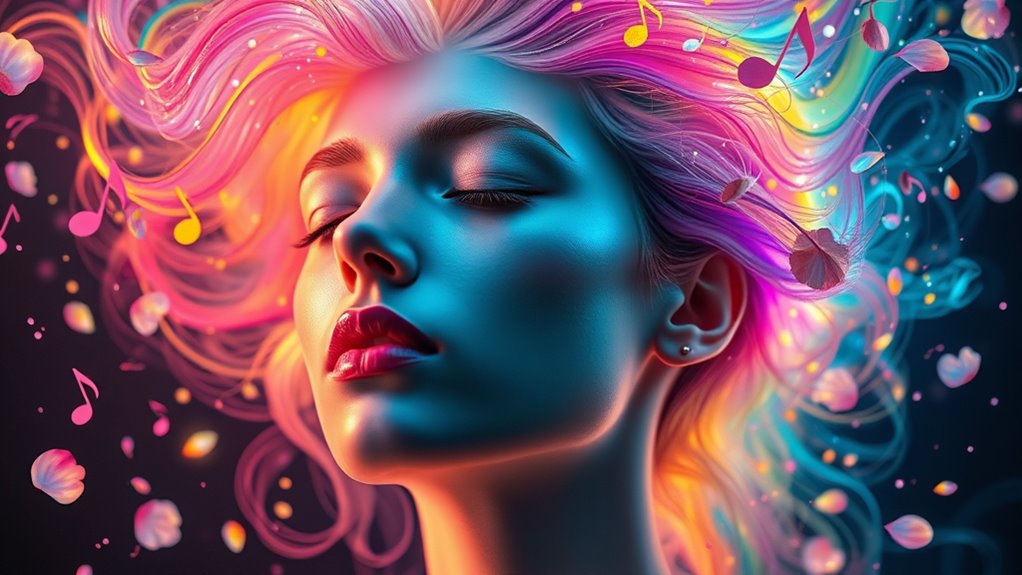Synesthesia is a fascinating neurological trait where your senses merge, causing you to experience involuntary overlaps like seeing colors when hearing music or tasting words. It’s not a disorder but a variation in sensory perception, thanks to increased connectivity between brain regions involved in senses. This cross-wiring can boost creativity, inspiring art, music, and writing. If you want to understand how these extraordinary experiences shape perception and perception’s limitless potential, keep exploring further.
Key Takeaways
- Synesthesia is a neurological phenomenon where senses involuntarily cross, creating blended sensory experiences like seeing colors when hearing sounds.
- It results from increased connectivity between brain regions responsible for different senses, supporting sensory crossover.
- Synesthesia enhances artistic expression by inspiring multi-sensory creations in music, art, and writing.
- It demonstrates the brain’s plasticity and ability to forge unique perceptual pathways beyond typical sensory boundaries.
- Experiences vary widely, including seeing colors, tasting words, or feeling sensations, illustrating a fluid and interconnected perception of senses.

Have you ever experienced seeing colors when hearing music or tasting words? That’s a hallmark of synesthesia, a fascinating neurological phenomenon where the boundaries between senses blur. When you have synesthesia, your brain processes sensory information in a way that creates a crossover, allowing one sense to involuntarily evoke another. Neuroscientific research has shed light on how these unique connections occur, revealing that synesthesia involves increased connectivity between different brain regions responsible for processing various senses. This neural wiring enables you to see, taste, or feel in ways most people never experience. Rather than being a disorder, synesthesia is often considered a variation in sensory perception—an extraordinary form of neurological diversity that can enhance artistic expression. Many synesthetes develop remarkable talents in music, painting, or writing, using their cross-sensory experiences as a creative tool. For them, colors might influence their compositions, or tastes might inspire their poetry, turning sensations into art. Artists and musicians with synesthesia often describe their work as inherently richer and more vivid because their senses are intertwined. Their creative process is deeply rooted in these involuntary associations, allowing them to craft multi-layered works that resonate on a sensory level. The scientific community has long been intrigued by how synesthesia shapes artistic expression, prompting studies that explore the link between sensory crossover and creativity. Researchers have found that synesthetes tend to show heightened activity in certain brain areas involved in sensory integration, suggesting that their brains are wired differently from the start. This wiring not only influences their perception but also fuels their inspiration. Whether it’s a painter seeing a specific hue when hearing a certain chord or a poet tasting words and translating those tastes into vivid imagery, synesthesia offers a window into the limitless potential of the human mind. It challenges the conventional understanding of perception, demonstrating that sensory boundaries are not fixed but can be fluid and interconnected. For you, experiencing synesthesia might mean a richer, more colorful world—one where senses dance together in unexpected harmony. Neuroscientific research continues to explore this phenomenon, revealing how the brain’s plasticity allows for such extraordinary experiences. Interestingly, studies of highly interconnected brain regions suggest that synesthetes have a different neural wiring pattern that supports these unique cross-sensory experiences. Ultimately, synesthesia exemplifies how the brain’s ability to forge unique pathways can turn everyday perceptions into extraordinary artistic expressions, expanding what we consider normal sensory experience. It’s a reminder that your mind’s wiring can create beauty and meaning from the most unlikely combinations of senses.
Frequently Asked Questions
Can Synesthesia Be Cured or Treated?
You might wonder if synesthesia can be cured or treated. Currently, there are no definitive treatment options or cures for synesthesia, as it’s a neurological condition rather than an illness. Some therapies, like cognitive-behavioral therapy, may help manage associated challenges, but their effectiveness varies. Ultimately, understanding and acceptance are key, and most people with synesthesia find it doesn’t require treatment, since it’s a unique part of their perception.
Is Synesthesia More Common in Any Specific Gender?
You might find it interesting that studies show women are about three times more likely to experience synesthesia than men, highlighting notable gender differences in prevalence statistics. This suggests that gender may influence how neural pathways develop or connect. While the exact reasons remain unclear, understanding these differences can help researchers explore genetic or hormonal factors playing a role in synesthesia’s occurrence.
How Does Synesthesia Affect Daily Life and Relationships?
You might find that synesthesia influences your daily life and relationships by enhancing sensory integration, making experiences more vivid. It can deepen emotional perception, allowing you to connect more intensely with others’ feelings or art. However, it may also cause challenges, like sensory overload or misunderstandings if others don’t share your perceptions. Embracing these unique experiences can foster empathy and creativity, enriching your relationships and personal growth.
Are There Famous Individuals Known for Synesthetic Experiences?
Did you know that about 4% of the population experiences synesthesia? Famous synesthetes include musician Stevie Wonder and artist Wassily Kandinsky, whose unique perceptions influenced their work. Some celebrity experiences with synesthesia have inspired creative projects, showing how this condition can enhance artistic expression. As you explore these stories, you’ll see how their sensory blending shapes their lives and careers, making their experiences both fascinating and inspiring.
Can Synesthesia Develop Later in Life or Is It Congenital?
You might wonder if synesthesia can appear later in life or if it’s only congenital. The answer is yes, it can develop as late onset or acquired synesthesia, often triggered by brain injury, neurological conditions, or certain medications. While most synesthesia is present from birth, some people experience it after specific events, showing that this fascinating sensory merging can indeed occur later in life, not just congenitally.
Conclusion
As you reflect on synesthesia, you realize it gently blurs the lines between senses, creating a beautifully unique world inside your mind. It’s like a delicate dance where colors whisper and sounds paint pictures, offering a soft reminder that perception isn’t always straightforward. Embrace this gentle merging, for it’s a quiet gift that invites you to see the world through a softer, richer lens—an exquisite reminder that sometimes, differences can create the most heartfelt beauty.









